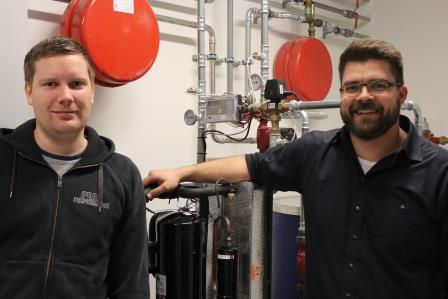
Million donation turns student project from MCI into energy venture in Sønderborg
A donation of 1.22 million from the Bitten and Mads Clausen Foundation elevates engineering student project to green energy development effort.
In 2012, engineering students from SDU Sønderborg constructed a system in the university building Alsion, which by means of sea water from the Alssund cools or heats a part of the building with cheap, green energy. The project was part of a larger interdisciplinary project where students from all engineering study programs at SDU Sønderborg participated. The project received the Alsion Innovation Award in 2013, and the system has since been in operation. Two of the students from the project, Michael Sørensen and Henrik Andersen, have believed in the potential of the technology of the system from the beginning. They have now succeeded in convincing others as well.
Donation of 1.22 million DKK
The Bitten and Mads Clausen Foundation has donated 1.22 million DKK to the project, which is now called Green Water. The money will be spent on developing a facility, with the prototype in Alsion as its starting point, and to test it in a so-called proof of concept project. This means that the technology will be further developed and subsequently can be installed in new constructions. The donation from the Bitten and Mads Clausen Foundation is granted to the Mads Clausen Institute, the University of Southern Denmark, which runs the project.
-The Green Water project perfectly reflects the MCI’s vision of a close and fruitful cooperation between mechatronics and innovation and business as well as our mission to assist the entrepreneurs among our students. The project has great potential – in study program activities, industry cooperation and green technology development, says Institute Manager of the Mads Clausen Institute, Professor Horst-Günter Rubahn.
From student project to research
At the MCI, the project is therefore elevated to collaboration work across the research groups Mechatronics and Innovation and Business, and several student projects will be launched to investigate e.g. mathematical models of constructions as well as energy consumption and demands. The research and development work is headed by Professor Alexander Brem, and Michael Sørensen and Henrik Andersen have been employed as scientific assistants on the project concurrent with their engineering master studies in Innovation and Business and Mechatronics respectively. For the two engineering students, getting this far with the project has been a hard process.
- We’ve been very close to giving up the project several times. There have been many obstacles we’ve had to overcome, so we’re very proud of having come this far and we’re very impressed by the support we’ve received. We wouldn’t have made it without assistance from the SDU and many others, say the two engineering students.
The municipality of Sønderborg has put a placement of DKK 350.000 and buildings at the project’s disposal. In addition, Project Zero, Idea Entrepreneurship Centre, CLEAN, the EU project Transformer and the Development Council Sønderjylland contributed to the project with access to know-how and networks.
Facility installed in Hardeshøj village hall
The new facility which will test the technology will be constructed in Hardeshøj village hall, situated at the ferry landing in Hardeshøj. Thus, it is well suited as an innovation lab. The facility will cool and heat the village hall, which houses motorcycle club, diving club as well as function and meeting rooms. The first sod is cut during the month of March and is expected to be finished in the summer of 2015.
For further information about the Green Water Research Project, please contact Michael Sørensen via e-mail mats@mci.sdu.dk/ph. 6160 2400, Henrik Andersen via e-mail han@mci.sdu.dk/ph. 5194 9396, or project manager at SDU, Professor Alexander Brem via e-mail brem@mci.sdu.dk/ph. 6550 9246.
FACTS:
The Green Water facility employs sea water from a certain depth of water and harvests the energy stored in the water to either heat or cool buildings. The facility can replace conventional air condition systems, which are high maintenance and polluting. It uses very little power on cooling, as the sea water is already cold, and at the same time it offers the possibility of heating by means of an integrated heating pump system.
Photo: Henrik Andersen (left) and Michael Sørensen by the original system in the basement of Alsion.